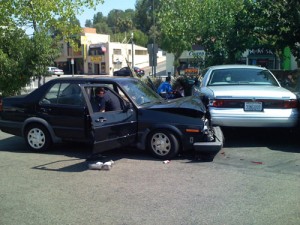I was not surprised to read the other day that 25% of collision claims occur when “backing up”. It only makes sense. Backing up isn’t something all drivers do with regularity, especially young drivers. But of all the types of collision types, the “backing up” collisions are the most avoidable.
Here are a few tips you can share with the other drivers in your home and other friends:
1. Know your car’s blind spots – the mirrors definitely don’t give the full view
2. Think ahead before you put yourself into a position where you’ll have to back up to get out.

3. Walk behind your car before you back up to spot potential hazards like fencing, poles, wet/soft areas, and most of all other people, especially children.
4. Tap the horn twice to alert others that you’re moving in reverse.
5. For goodness sake, back slowly!
6. Enlist a spotter (could be a passenger or bystander) to guide you but make sure you agree in advance on what hand signals you’ll use.
7. Keep your driver-side window down and your radio off – the fewer the distractions, the better.
I hope these tips help you and your family the next time you find yourself in a “tight spot”.
Can you think of other tips?
One more thing, most all backing up accidents happen in parking lots, look for places that you don’t have to back out, park father away than other vehicles. and pre backing it. so when you leave all you have to do is pull out!
Looking for a Tampa Auto Insurance quote? Click on the link for all the information. Browse through our Auto Insurance Blogs for more useful tips.
Hope this helps!
Grace and Peace,
Eric Most




Backing up can be a tricky thing and it is so important to take it slow and check for your blind spots. I can believe it is a major culprit when it comes to auto claims.
Sadly, it is not enough to TELL people about the blind spots. In my 20+ years of teaching traffic safety, I have found that very few people even know WHERE the blind spots are, and how to correctly “check” them.
Also, I recommend to my students that they get in the habit of the “Bowtie System” of keeping your eyes moving: Look ahead, then glance at the rear-view mirror, back ahead, glance at the left side-view mirror, back ahead, glance down to the instrument panel, back ahead, and then glance to the right side-view mirror. If done correctly, your eyes are seldom away from the path of travel (which includes peripheral vision) and yet you gather all the information needed to drive safely in just a few seconds. This should be repeated every 100-200 feet, since that is the average distance that “new” dangers appear in urban driving.
As to backing up, ALWAYS look out the back window while backing. Each time you turn your head to examine front or sides, your brain must recalculate “where am I?”, which leads to confusion an misreading your distance, speed, and other traffic, especially in parking lots. Remember, many cars now have cameras for “backing up”, but they don’t tell you what is coming from the sides, or at an angle to the camera. USE YOUR EYES!!!